|
July
27
Today
was my birthday! I couldn’t think of a better way to spend it.
We stood by the campfire and watched the pre-dawn light start to
glow in the sky. We heard a hyena call at breakfast, a loud one -
perhaps he was wishing me Happy Birthday.
Gee asked me - what did I want to see for my birthday?
I laughingly told him if I saw even one impala, francolin
or elephant I would be happy. The trip had been so remarkable that
I didn’t want to ask for something that might not happen -
though I did secretly hope to see the wild dogs hunt again.
Since it was my birthday, I nabbed the front ‘shotgun’
seat; I liked sitting there where I could see out the front and
talk to Gee. Each seat had a slightly different viewpoint, and we
rotated daily. We watched the sunrise, glowing through the trees
like fire. A pair of green and brown Meyer’s parrots hopped
along a leaning tree. There was plenty of waterfowl around; a shy
slaty egret was a new one for us. A great egret, a yellow-billed
stork and a hamerkop waded in the same pool.
We drove through a riverine forest. In the cool morning
light, the sandy roads appeared blueish in the shadows. Several
zebras moved quietly through the trees, and an impala stared at us
indignantly before drifting across the roadway. We passed the
campsite we had used on the previous trip; back then it had been
dry, but now the lagoon was filled with water, complete with crocs
and hippos.
We came to a beautiful marshy pond with dead trees standing
up out of the water, and reeds and marsh grasses hemming in the
edges. A goliath heron waded near a fallen tree. Nearby, the road
was blocked by a deep steep-sided hole, perhaps 12 feet across and
at least 5 feet deep, with water covering the bottom. As we went
around this treacherous pit, Gee told us that one time when the
road was flooded, Pula drove into the submerged hole and got
hopelessly stuck. Unable to free the vehicle, he and the guys had
to set up the camp right where they were – tents, kitchen,
dining tent and all. Ever since, the location has been known as Pula’s Camp.
Near the edge of the woods were several kudus; a large
female, her coat fluffed up from the cold, stood quietly while
several oxpeckers sifted through her fur. A young male with small
spike horns was grooming himself intently.
Four giraffes moved through the forest, graceful as a
dream, gliding silently through the trees.
We left the forest and came out on to a wide floodplain. A
beautiful white egret flew just above the river, its reflection
matching its wings beat for beat. A bateleur eagle was sitting in
a tree, recognizable in silhouette by his broad owl-shaped head
and short tail. A leopard orchid grew on a high branch. We came to
an area of white soil; Gee said it was sodium bicarbonate, from
which the salt pans are formed.
We crossed a new-looking bridge, very narrow with the poles
set lengthwise; we could see the old abandoned bridge a hundred
meters off to the side falling into disrepair. Tall termite hills
rose out of the floodplain, surrounded by reddish cottonwood
grass.
Around mid-morning Gee pointed out some tracks and said
they were from buffalo; this statement was met with skepticism, as
we had become convinced that African buffalo must be mythical
creatures, like unicorns.
Of course, four of us had been on safari before, so we knew
that buffalo did exist - and even though the other three had not,
I’m pretty sure they knew as well. But we had stated our
skepticism so often that Gee may have been feeling a little
pressure to come up with some buffalo. By this point he may not
have been exactly sure of what some of our group believed - which
was exactly our motive.
Four zebras stood quietly, lined up on the open plain near
a waterhole, their stripes crisp and clean in the clear morning
light. Gee told us that scientists compare stripe patterns on
zebras’ shoulders and under their eyes to identify individuals.
A small herd of lechwe ran by ahead of us, their front ends
low to the ground as their powerful hindquarters propelled them
forward. One of the mothers stopped, allowing her baby to nurse
from a kneeling position. A family of saddle-billed storks, a
father with two juveniles, waded through the tall feathery
miscanthus grass that was blowing in the breeze. These are Gee’s
favorite bird.
|
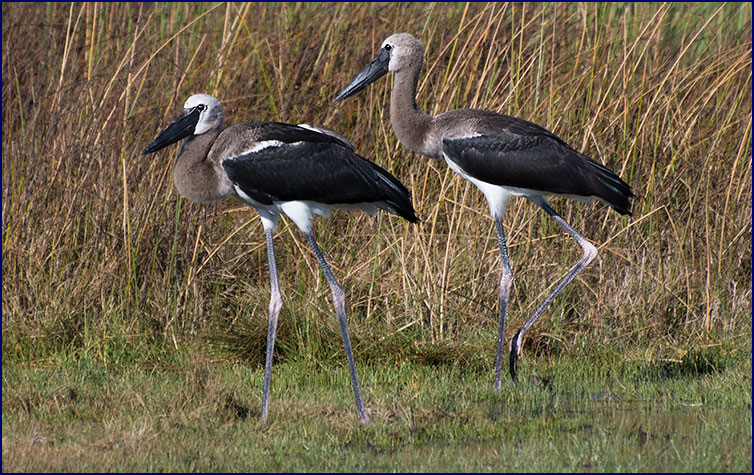
Juvenile saddle-billed storks
|
The birds were out in force. A handsome southern
white-crowned shrike looked down us from his perch in a tree. An
African marsh harrier circled around, buzzing a fish eagle as it
flew down out of a tree. A couple of blue waxbills and a
crimson-breasted shrike lent flashes of brilliant color to the
scene. A Cape turtle dove perched in a thornbush. A blacksmith
plover sat on her nest in the grass, fiercely guarding her eggs.
An African stone chat stood on a log, close enough for us to catch
the gleam in his eye, and then flew off in a flurry of feathers.
|
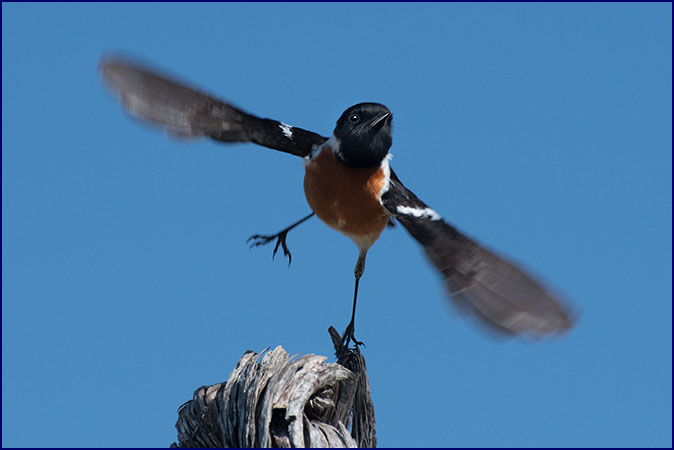
African
stone chat
|
We took our tea break under a lone marula tree. Its twisted
trunk and multi-colored wood was beautiful, but much scarred by
elephants - they crave the sweet fruit produced by these trees.
Baboons have been known to get drunk off of the fruit when it
ferments; I have heard some say that the elephants do too, but Gee
told us that is not true. A fine liqueur called Amarula is made
from the fruit of the marula tree, much like Bailey’s Irish
Cream - some safari guests have been known to get drunk off of
that.
At last we found the elusive buffalo! Gee drove across a
wide expanse of dry yellow grass, and at the far side of it was a
large herd of about a hundred African buffalo.
Most of them were lying down sleeping; we could see their
curved horns sticking up through the tall grass.
|
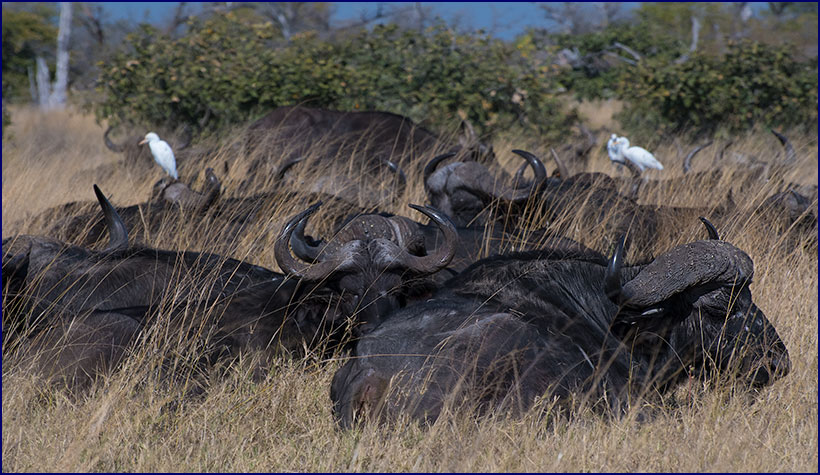
African buffalo |
The buffalo are black, with sparse patchy coats. The larger
bulls weigh up to 2200 pounds. Both males and females have large
curving horns, but the males’ horns are larger and heavier,
fused at the base to form a continuous boney shield across the
back of the skull called the boss.
Their ears are split in three sections to blend in with the leaves
on the trees. Along with elephants, zebras and wildebeest, buffalo
are migratory.
Several cattle
egrets perched on bovine heads and backs, picking off parasites,
along with the ubiquitous oxpeckers. Gee told us that oxpeckers
sleep in holes in trees at night, and make nice fluffy nests of
animal hair.
Several large buffalo bulls appeared to be standing guard;
they seemed powerful and slightly sinister as they stared at us
nearsightedly. Although the herd was quiet they watched us warily
– it was clear that these were not animals to mess with. Buffalo
are considered one of the most dangerous animals in Africa; the
older bulls that have separated from the herd tend to be
especially grumpy.
We watched the buffalo a long time, glad to see that they
were not mythical after all. Presently they stood up and started
to mosey away. There were several babies with the herd, their
coats a lighter brown color. We noticed that the cows have their
teats on the back of their udders, so the babies could nurse from
the rear while the herd was walking along. Gee said that buffalo,
along with warthogs, are the tastiest animals; predators prefer
them – though it takes a quite a strong hunter to bring down a
buffalo.
Not far from the buffalo herd, a group of zebras relaxed
beside a wide shallow lagoon. Several of the babies were lying
down taking a nap. We admired one young fellow with a shaggy baby
coat; his black stripes still had a brownish tinge. He had a bushy
mane and a forelock way too big for the rest of him. Two
adolescent male impalas were having a mock battle; they stood with
heads low and horns interlocked, each straining to push the other
backward.
We passed a great spreading tree with large seed pods
hanging down from the branches; it was a sausage tree.
Giraffes, kudus and baboons all eat the sausage fruit, Gee
told us, and mokoros are sometimes made from the trunks. He picked
one of the fruits for us; it looked like a giant slightly obscene
version of a sweet potato, well over two feet long.
The abundance of wildlife was truly impressive. Looking
around, we could see impalas, zebra, lechwe, tsessebe, giraffes,
and wildebeest all from the same spot, not even counting all the
birds. A particularly lovely dark zebra strolled by, with black
stripes much wider than the white.
A mother giraffe was eating the fruit from a sausage tree,
her baby by her side. Soon the baby started to nurse, snaking his
long neck down to reach his lunch. After a while they came out of
the trees into an open meadow, where they were joined by a big
male giraffe, presumably the father. The male went over to a
stream to drink, looking around carefully before crouching down
low on buckling legs to reach the water.
The
giraffe family marched regally across in front of us, the baby
leading and Dad bringing up the rear. The mother and the youngster
were a bright chestnut color with white edging on their patches,
and the male was a darker mahogany brown with tan edges. The
family crossed a deeper channel, pausing before taking the plunge
across one by one. It was an incredible privilege to watch them.
As
we headed back to camp, we paused by the same little lagoon with
the dead trees reflected in the water; it seemed almost like a
tropical spot. A pair of grebes floated on the mirror-like
surface, and a Burchell’s starling looked down at us from a
thornbush. A male jacana with one long-legged chick picked their
way through the shallows; Gee explained that the female jacana
lays the eggs, but then the male incubates them and raises the
chicks while the mom goes off and finds another mate and lays more
eggs.
|
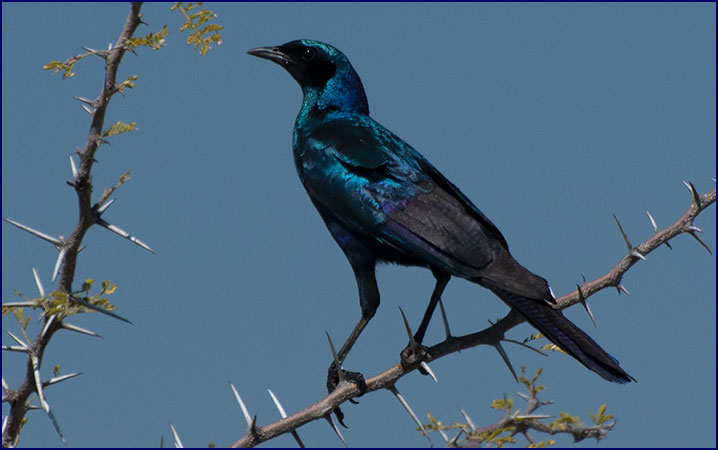
Burchell’s starling
|
We saw buffalo again, several of them hanging out under a
tree. A spur-winged goose dabbled in a pool before taking wing. We
heard a very high-pitched cry, who
whoo whooo; Gee told us it was the wild dogs, calling out to
locate one another after hunting. Gee mimicked the sound, calling
to them. We rolled happily into camp to find Phillimon waiting.
We had another excellent lunch, complete with fresh salads
and camp-baked bread. An arrow-marked babbler joined us after we
ate, a grey-brown bird with tiny white arrow marks and orange
eyes, hopping around the table looking for crumbs. We rested a
bit, reading and walking around camp, or taking advantage of the
bucket showers. We noticed elephant dung just outside the tent; it
had not been there in the morning. The campsite was a gorgeous
spot, with the tent set among towering trees. I got everyone to
pose for a group photo in front of the Landcruiser before the
afternoon drive.
Setting out in the afternoon, we were just a few minutes
out from camp when we paused by a beautiful lagoon. Looking out
across the water, we could see a huge eagle’s nest high in a
tree, and a buffalo weaver’s nest hanging below it. A small
green-backed heron sat at the water’s edge, and a large
crocodile lay in the shallow water. The haunting cry of a fish
eagle wafted over the water.
A family of vervet monkeys climbed on a fallen tree, two
adults and two youngsters. They sat in a row, bringing to mind see
no evil, hear no evil, speak no evil.
Two of them left, scampering down the log, but a mother and baby sat peacefully
together, long tails outstretched, gazing about the forest. A
crested barbet perched on a tree trunk; these charismatic little
birds are variegated yellow, red, black and white with a perky
topknot. They are quite attractive, despite having a somewhat
scruffy head.
|
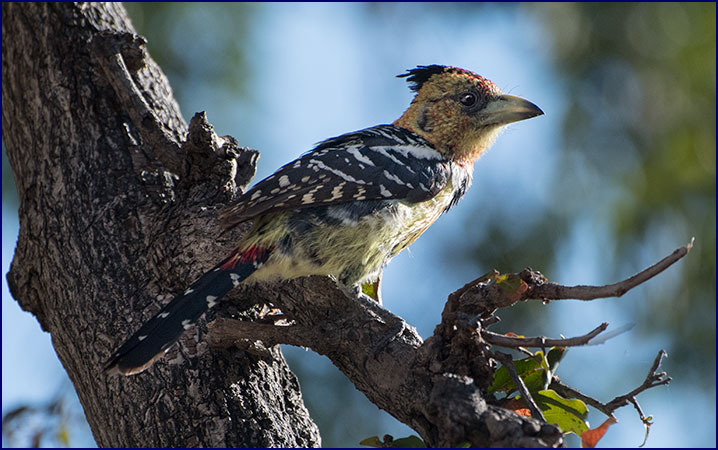
Crested
barbet |
We encountered two guys in a self-drive car, and they
showed us where they had seen wild dogs. When we got to the spot
there were about a dozen dogs sleeping on the ground – they were
thin and looked hungry. We could see that one was a nursing
female. Another wore a radio research collar. The dogs were
sleeping hard; they took no notice when a business of banded
mongoose went right by them. Gee told us that they would
soon get up and hunt, so we
decided to stay and watch the dogs for a while in hopes of some
action.
Soon the dogs started to show some signs of life. One after
another they would get up, then yawn and stretch. Before long they
were all up and milling around in the road restlessly. They set
out to hunt and we followed them. They moved in a straggly line
along the road, stopping often to look around, sniffing the air
and listening intently. It
was all very low key at first, but the dogs were getting more
animated as they went on. They began to fan out, and picked up a
brisk trot. They appeared to have a plan; I observed two dogs
touch noses in apparent communication and then move off in
different directions. Gee kept the Landcruiser a short ways behind
them, trying to keep them in sight without interfering with the
hunt.
There was a flash of motion and an impala dashed away, and
the dogs were after him in a flash, in hot pursuit. We followed
them, trying to keep up as they spread out and ran hard, crossing
water, going through woods and across open fields. Gee always
seemed to know just where to go for us to see the most. He said
that impala should have hidden instead of trying to run; the wild
dogs are the second fastest predators after cheetahs, and with far
greater stamina.
We came upon them just seconds after they killed the
young impala, and watched as they tore it apart. It was intense
and violent – not exactly pretty to watch – but it was the
circle of life, nature at its most vivid.
The dogs pulled the carcass into pieces and began to eat;
most of them grabbed a piece and moved away to eat it undisturbed.
Their faces were bloody from the kill as they gnawed on the bones.
Several dogs that arrived later were enthusiastically greeted with
high-pitched yipping and tail wagging. There was a little
good-natured squabbling over the choicest bits, but no real
fighting.
Having
eaten, the dogs were quite relaxed now; some of them started to
yawn and stretch in preparation for a nap. However many of the
dogs still seemed to be hungry; one small impala for a dozen dogs
was not a lavish meal. They seemed to be saying, That was a good appetizer, now where is the main course? They
started to get up and move about restlessly.
Before long the dogs were on the hunt again, fanning out
and moving through the brush, slowly at first, and then with more
purpose. We followed, trying to keep track of them in the fading
light. Soon they were running hard again, and we
were flying after them. A giraffe walked right in front of the
pack of hunting dogs, but they were after smaller prey.
A grey Go-Away bird gave his signature Go
Away call, but we ignored him. A big male baboon had a tantrum
as the dogs ran past him, screaming and aggressively chasing them;
they yielded out of expedience.
We were still following the dogs; they turned and ran right
past our camp. Phillimon was waiting with the tea, and we ended
the hunt there. Incredible!
At dinner I found my chair was decorated with birthday
streamers - and to my amazement, Birthday Bear was there! Birthday
Bear is a little white teddy bear that Jineen and I pass back and
forth on our respective birthdays; she had brought him all the way
to Botswana in her backpack. I think he was a little traumatized
by the trip, but he and Duma became good friends.
|
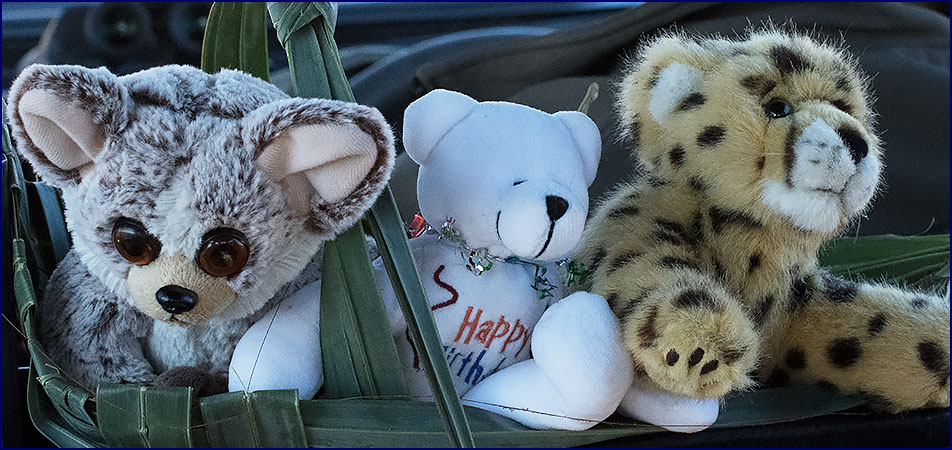
Birthday
Bear with Fred and Duma |
We had an excellent dinner and a great evening around the
campfire. I managed to
blow out all the candles on my birthday cake, but all my wishes
had already come true. A wild dog hunt on my birthday – what
more could I even imagine?
We had just gone to our tent when the hyenas came. Suddenly the
night was pierced by unbelievably loud high-pitched whooping
noises and shrieks of maniacal laughter. I had never heard
anything like it before, but I knew immediately, unmistakably,
that it was hyenas. I had always vaguely wondered why they called
them ‘laughing hyenas’, as the soft whoops and calls I was
accustomed to hearing from them did not sound like laughter at
all. But this did - like incredibly loud hysterical laughter from
some deranged insane asylum escapee! Chills went down my spine.
I grabbed my headlamp and went out the front of the tent,
scanning the darkness, seeking the makers of those bone chilling
cries; Jineen was right behind me. We shined our lights into the
night, searching. Suddenly I saw glowing eyes, just outside the
light of the lanterns; five or six pairs, staring back at me
intently. Whoa! OK, I think it is time
to go back in the tent now. We retreated back inside the
canvas, peering out the thin mesh door.
Two
hyenas walked right into camp as if they owned it. They let out
their haunting cries again as they squabbled, walking right
between our tent and Patty’s. Perhaps they were arguing over
which of us to eat first? We leaned out the tent flap, awestruck.
They were huge! Second in size only to the lions among the
predators of Africa, the hyenas have powerful jaws that can crack
elephant bones. When looking down at hyenas from the safety of the
Landcruiser they had seemed imposing enough - but seeing them now
at eye level from thirty feet away was a completely different
experience. And listening to their terrifying shrieks and cries
was not something I would forget any time soon.
About
that time Gee pulled the Landcruiser up into the middle of camp
and turned the headlights on; the hyenas stood frozen in the
glaring light for a few moments, and then disappeared back into
the night. Gee’s voice came floating through camp; “That was amazing!”
It
was an incredible display; I won’t forget it for a long, long
time. I could not have asked for a better birthday.
|